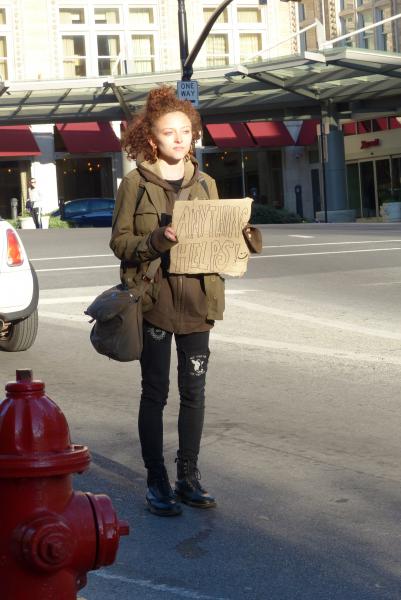
Five Things I’m Learning from Individuals Experiencing Homelessness
Today I’m happy to host Ethel Gould as a guest blogger. During her seminary arts apprenticeship, she has served as a writer for a ministry to our neighbors experiencing homelessness. Here she passes on some of what she’s been learning:
A panhandler’s presence on a street corner has always brought to my mind an old story about seminary students stepping over a homeless man on their way to a final exam about Jesus’s parable of the Good Samaritan. But still, before I reached for the change cup in my car, I'd worry that my cash might contribute to an addiction. Then I worked for a drop-in center that serves individuals experiencing homelessness. And I learned a few things from friends who make the streets of Dallas their home:
But still, before I reached for the change cup in my car, I'd worry that my cash might contribute to an addiction. Then I worked for a drop-in center that serves individuals experiencing homelessness. And I learned a few things from friends who make the streets of Dallas their home:
1. Homeless people aren’t all the same. As with any segment of the population, stereotypes do more harm than good. I’ve met parents, veterans, teachers, and even a pastor who now make the streets their home. Other individuals experiencing homelessness have part-time jobs, some live in cars, and one I know has lived under the same bridge for twenty-three years. Some homeless folks are nearly blind, others are unable to hear, and a few use walkers to get around. A few homeless individuals have called the streets their home since they aged out of foster care when they were eighteen years old. One thirty-eight year old, Evan,* was paid $200 by his foster parent when he was sixteen to leave the foster system; he’s lived on the streets ever since. Many of our neighbors experiencing homelessness suffered physical and sexual abuse at a very young age. Some in the homeless community struggle with schizophrenia or other mental illness; many of these individuals abuse substances to help them quiet internal voices. A few of our homeless neighbors will always live on the streets—so conditioned by horrific circumstances they are unable to survive any other way.
2. Don’t give money to panhandlers. It might ease your conscience to drop some change into a panhandler’s cup, but chances are, you are making the homeless individual’s situation worse by giving them money. How? A few months ago, my friend Danny showed me his new cardboard sign. In bright red, blue, and green letters, he’d written: “Anything Helps. Please Give. Thank you.” A sun, flowers, and butterflies decorated the corners. But I knew Danny was addicted to drugs. So I asked him, “Will you buy food with the money you get with your sign?” He laughed and said, “No. Dallas feeds me too well. I’m going to buy Meth.” I knew Danny was trying to shock me with his brazenness. But before I mentally criticized too much, one of the other employees reminded me that he was sexually abused as a child. Meth helps him forget.
3. If you give cash to a woman who panhandles, you might as well hand the money over to her pimp and congratulate yourself on enabling human trafficking. If you are like me, giving cash to a female panhandler is much more tempting than giving it to a man. For this reason women make more money panhandling than do men. But most women who live on the streets need a relationship with a man to keep “safe.” Street life is just too hard for a woman to survive by herself. But the “protection” comes with a steep price: sexual favors, physical abuse, money, and even prostitution. Many men tell the woman they’ve hooked up with to stay away until they’ve earned a certain amount of cash. When you give a homeless women money, she becomes a human vending machine. If you’ve read anything about victims who sympathize with their captors, you understand that many women experiencing homelessness suffer from Stockholm Syndrome. They often make excuses for the physical and sexual abuse they experience because they believe they brought the abuse on themselves. Many women even believe they deserve it.
4. A surprising number of our homeless neighbors are elderly. The average age of a homeless person in Dallas is 55. Many factors contribute to this: divorce, bankruptcy, family strife, as well as individuals who have recently been released from jail without a place to live. Regardless of the cause of their homelessness, this population is elderly and vulnerable.
5. Inexpensive housing isn’t a miracle remedy for those experiencing homelessness. Complex issues can plague many homeless individuals including mental illness and substance abuse. As a vulnerable population, many homeless individuals have been abused, and some homeless individuals have, frankly, been the abusers. Housing is only part of the solution that also needs to include help for substance abuse, mental health counseling, job training, and most importantly, a supportive community.
So the next time you see a homeless person, what can you do?
1. Treat them with dignity. Look them in the eye. Ask their name. Give them a bottle of water. If you are a person of faith, ask them how you can pray for them—and please do pray for them.
2. Advocate with your state representatives or city council to make more funding available for mental health organizations, homeless shelters, and foster care.
3. Volunteer for an organization that helps the homeless population in your city. I live near Dallas, Texas, and love OurCalling. They try to meet the physical and spiritual needs of individuals experiencing homelessness. Find one you can support and give financially. Ask what type of clothing or toiletry donations they need. If you belong to a community of faith, organize a group to volunteer with an organization that ministers to the homeless community. Such nonprofit organizations seek to understand the homeless culture; they know which items should be rationed so the shoes or backpacks aren’t used to barter for drugs and sex. They do a great work of meeting the physical and spiritual needs that the church and state miss. Who knows? By volunteering for a nonprofit to help the homeless community, you might see Jesus’s parable of the Good Samaritan lived out right before your very eyes.
*Name changed to protect identity


